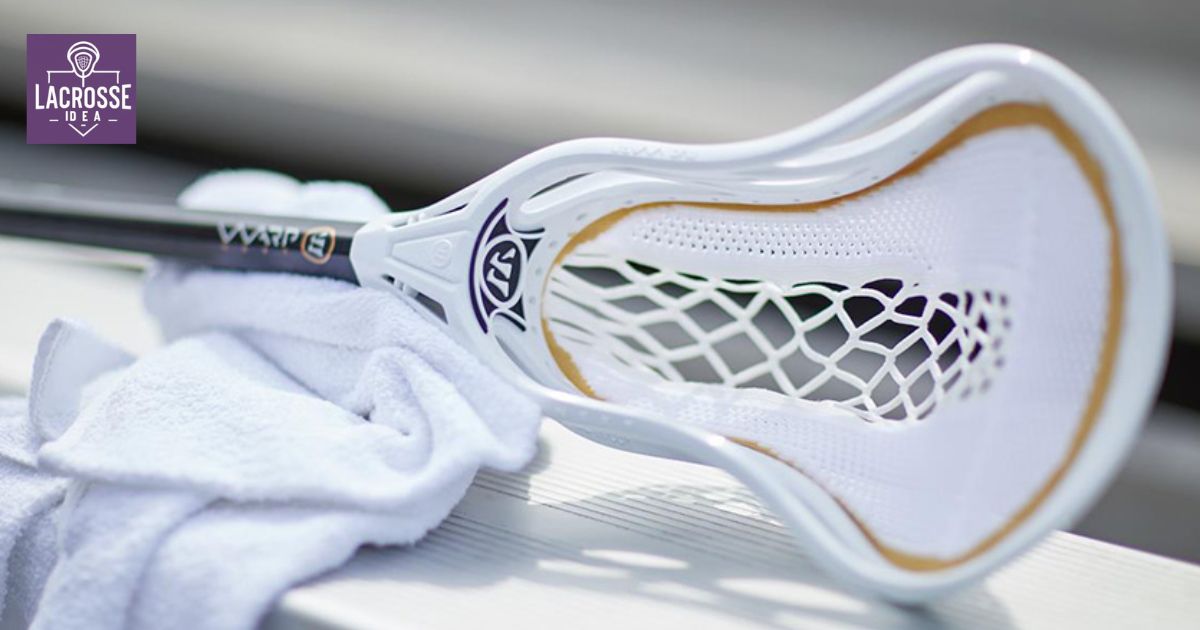In the realm of lacrosse, breaking in a stick can be likened to an artist priming a canvas, readying it for the masterpiece to come. Just as a painter carefully prepares their brushstrokes, we too must meticulously prepare our lacrosse sticks before taking to the field. This article will guide you through the art of breaking in a lacrosse stick, ensuring optimal performance and a sense of belonging in the vibrant community of lacrosse enthusiasts.
Key Takeaways
- Assess the specific position and playing style to determine the right lacrosse stick.
- Understand the different types of lacrosse sticks: attack/midfield, defense, and goalie sticks.
- Test and evaluate the flexibility of the mesh for optimal stick performance.
- Adjust the mesh tension and regularly maintain it for consistent performance.
Choose the Right Lacrosse Stick
To choose the right lacrosse stick, it is essential to consider the specific position and playing style, as well as the player’s age and skill level. Understanding the different types of lacrosse sticks is crucial in making an informed decision. There are three main types of lacrosse sticks: attack/midfield, defense, and goalie sticks. Attack/midfield sticks are typically lighter and shorter, providing better control and maneuverability for quick movements and accurate shots.
Defense sticks, on the other hand, are longer and heavier, allowing for more power and reach when checking opponents. Goalie sticks are even longer and have a wider head to help with blocking shots. Additionally, considering the player’s age and skill level is important as they may require a stick that is more forgiving or offers more advanced features. By understanding the different types of lacrosse sticks and considering these factors, players can choose the stick that best suits their needs and enhances their performance on the field.
Assess the Flexibility of the Mesh
Assessing the flexibility of the mesh is crucial in breaking in a lacrosse stick. The flexibility of the mesh affects the performance of the stick, including its ability to hold the ball and deliver accurate passes and shots. To test the flexibility, players can try bending the mesh, checking for any stiffness or rigidity. Adjusting the mesh tension can also help achieve the desired level of flexibility.
Mesh Flexibility Importance
Evaluating the flexibility of the mesh is crucial when breaking in a lacrosse stick. The flexibility of the mesh directly impacts the player’s ability to control the stick and handle the ball effectively. By understanding the importance of mesh flexibility, players can improve their stick control and enhance ball control on the field.
To visually represent the ideas, here is a table highlighting the key aspects of mesh flexibility:
| Mesh Flexibility | Importance |
|---|---|
| Stiff mesh | Provides more accuracy and control when passing and shooting. |
| Soft mesh | Offers a better feel for the ball and improved ball retention. |
| Hybrid mesh | Combines the benefits of both stiff and soft mesh for versatile play. |
Testing Mesh Flexibility
Understanding the importance of evaluating the flexibility of the mesh, players can effectively assess the mesh’s flexibility to determine its suitability for their playing style and preferences. Testing the durability and measuring the mesh tightness are crucial steps in this process. Here are five ways to test the flexibility of the mesh:
- Perform a pinch test by squeezing the mesh between your fingers to evaluate its resistance and spring-back capability.
- Stretch the mesh by pulling it in different directions to assess its elasticity and how well it retains its shape.
- Observe the mesh’s response to impact by forcefully hitting it against a hard surface to gauge its ability to withstand pressure.
- Examine the mesh’s ability to absorb and release the ball by performing a ball drop test, where you drop a lacrosse ball onto the mesh and observe how it reacts.
- Test the mesh’s performance in different weather conditions, such as wet or cold environments, to determine its durability and reliability.
Adjusting Mesh Tension
To properly assess the flexibility of the mesh, it is important to adjust the tension accordingly. The tension of the mesh can greatly affect the performance of a lacrosse stick, so it is crucial to find the right balance. Start by loosening or tightening the sidewall strings to increase or decrease the tension. Experiment with different tension levels to find what works best for your playing style.
Maintaining the proper tension is essential for consistent performance. Regularly check the tension and make adjustments as needed to ensure optimal performance on the field. In the next section, we will discuss the importance of moisturizing techniques to keep the mesh in top condition. By moisturizing the mesh, you can enhance its durability and performance, allowing you to play at your best.
Moisturize the Mesh
Moisturizing the mesh is a crucial step in breaking in a lacrosse stick. By hydrating the mesh, you can enhance its flexibility and improve your performance on the field. In this discussion, we will explore various techniques for moisturizing the mesh and highlight the benefits of this important process.
Mesh Hydration Techniques
Hydrating the mesh is an essential step in breaking in a lacrosse stick. Properly moisturizing the mesh not only enhances its performance but also ensures its durability. Here are some effective mesh hydration techniques to consider:
- Pre-soaking the mesh: Soaking the mesh in warm water before use helps to soften the fibers and improve moisture absorption.
- Using a mesh conditioner: Applying a specialized mesh conditioner or wax helps to maintain the mesh’s moisture and prevent it from drying out.
- Regularly moisturizing the mesh: After every game or practice session, lightly spraying the mesh with water or a specialized mesh moisturizer helps to prevent it from becoming stiff and brittle.
- Avoiding excessive heat: Keeping the mesh away from direct sunlight or high temperatures prevents it from drying out and losing its moisture-absorbing abilities.
- Proper storage: Storing the lacrosse stick in a cool and dry place, away from moisture or extreme temperature changes, ensures the mesh remains in optimal condition and maintains its durability.
Benefits of Moisturizing
Properly maintaining the moisture levels of the mesh in your lacrosse stick is crucial for maximizing its performance and longevity. By moisturizing the mesh regularly, you can reap several benefits that enhance your gameplay experience. First and foremost, moisturizing helps to prevent the mesh from becoming brittle and prone to breakage. This is especially important during hot and dry weather conditions, as excessive dryness can cause the mesh to lose its elasticity and durability.
Secondly, moisturizing the mesh improves its grip on the ball, allowing for better control and accuracy when passing and shooting. Additionally, it helps to reduce friction and resistance, making the stick feel smoother and more responsive in your hands. So, make sure to incorporate proper hydration techniques into your lacrosse stick maintenance routine to enjoy these benefits and elevate your performance on the field.
Apply Heat to the Mesh
To accelerate the breaking-in process of a lacrosse stick, heat can be applied directly to the mesh. This technique helps to soften the mesh fibers, making it more pliable and easier to shape. Here are some benefits of applying heat to the mesh:
- Faster breaking-in: Applying heat to the mesh speeds up the breaking-in process, allowing players to use their stick sooner.
- Improved pocket formation: The heat helps the mesh mold to the desired shape, creating a deeper and more consistent pocket.
- Enhanced ball control: A well-shaped pocket provides better ball control, allowing players to catch and cradle the ball more effectively.
- Increased shot accuracy: A properly broken-in mesh allows for a more accurate release, improving shooting precision.
- Overall stick performance: Applying heat to the mesh ensures that the stick performs optimally, enhancing a player’s game.
With the mesh now softened and more malleable, the next step is to stretch the pocket, which we will discuss in the subsequent section.
Stretch the Pocket
After applying heat to the mesh, the next step in breaking in a lacrosse stick is to stretch the pocket. Stretching the pocket helps create a deeper and more responsive pocket, allowing for better ball control and accuracy. Here are some break in techniques and tips for breaking in a lacrosse stick:
| Techniques | Tips |
|---|---|
| Hand stretching | Apply gentle pressure and pull the mesh towards the sidewalls to stretch it evenly. |
| Shooting | Take some shots on goal to further stretch and form the pocket according to your preferences. |
| Wetting | Dampen the mesh with water before stretching to make it more pliable. |
| Knot adjustment | Adjust the knots on the sidewalls to fine-tune the tension and depth of the pocket. |
| Time and patience | Breaking in a stick is a gradual process, so be patient and repeat the stretching process as needed. |
Play Catch and Cradle
Continuing from the previous step of stretching the pocket, the next phase in breaking in a lacrosse stick involves playing catch and cradling. This step is crucial for developing your lacrosse skills and getting comfortable with your stick. Here are five essential tips to keep in mind while playing catch and cradling:
- Start by finding a partner to play catch with. This will help you improve your passing and receiving skills.
- Focus on proper technique, keeping your hands relaxed and wrists loose while cradling the ball.
- Practice different types of passes, such as overhand, sidearm, and underhand, to enhance your passing accuracy.
- Experiment with different speeds and distances to challenge yourself and improve your coordination.
- Incorporate dodges and fakes into your cradling to simulate game situations and develop your agility and stickhandling abilities.
Practice Shooting and Passing
Moving forward with the process of breaking in a lacrosse stick, it is crucial to focus on practicing shooting and passing to further enhance your skills and proficiency on the field. By dedicating time to these fundamental aspects of the game, you can improve your stick handling and increase your shot power, making you a more formidable player. Practicing shooting allows you to perfect your aim and accuracy, enabling you to score more goals during games.
Additionally, regular passing practice helps to develop your ability to make quick and accurate passes to your teammates, contributing to effective team play. By consistently practicing shooting and passing, you will not only strengthen your individual skills but also increase your value as a team player, ensuring a successful lacrosse experience.
Break in the Shaft
To begin breaking in the lacrosse stick shaft, it is important to focus on properly conditioning and preparing the material for optimal performance on the field. Here are some key steps to follow:
- Check mesh tension: Make sure the mesh is properly tightened and secured to the shaft. Adjust it as needed to achieve the desired responsiveness.
- Inspect the pocket: Regularly examine the pocket for any signs of wear and tear. Repair or replace any damaged parts to maintain a consistent performance.
- Maintain pocket depth: Keep an eye on the pocket depth and make adjustments to ensure it complies with the rules of the game.
- Clean and dry the shaft: After each game or practice session, clean the shaft thoroughly and let it dry completely. This helps prevent moisture-related issues and extends its lifespan.
- Protect the shaft: Use protective tape or a shaft cover to minimize damage caused by checks and impacts during gameplay.
Maintain and Care for Your Lacrosse Stick
To properly maintain and care for your lacrosse stick, it is essential to prioritize regular cleaning and inspection for any signs of damage or wear. By doing so, you can extend the lifespan of your stick and ensure optimal performance on the field. When choosing a lacrosse stick, it’s important to consider the type of mesh used.
Mesh maintenance is crucial for maintaining a consistent pocket and enhancing ball control. Regularly check the mesh for tears or fraying, and if necessary, replace it promptly. Additionally, clean the mesh with mild soap and water to remove dirt and sweat buildup. To provide further guidance, refer to the table below for a comprehensive overview of lacrosse stick maintenance:
| Maintenance Task | Frequency | Description |
|---|---|---|
| Cleaning | Weekly | Use mild soap and water to remove dirt and sweat buildup. |
| Inspection | Monthly | Check for signs of damage, such as cracks or loose parts. |
| Mesh Replacement | As needed | Replace torn or frayed mesh to maintain a consistent pocket. |
Frequently Asked Questions
How Long Does It Typically Take to Break in a Lacrosse Stick?
The time it takes to break in a lacrosse stick varies depending on several factors such as the quality of the stick, the materials used, and the techniques employed. Understanding these factors is crucial for effectively breaking in a lacrosse stick.
Can I Break in a Lacrosse Stick Without Using Any Heat or Moisture?
Breaking in a lacrosse stick without heat or moisture requires alternative methods. While heat and moisture are commonly used, other techniques can be employed, such as repeatedly flexing the stick or using a specialized tool to loosen the fibers.
What Are Some Common Mistakes to Avoid When Breaking in a Lacrosse Stick?
When breaking in a lacrosse stick, it is important to avoid common mistakes and use proper technique. By understanding the potential errors, players can ensure a successful break-in process and optimize their stick’s performance on the field.
How Often Should I Moisturize and Maintain the Mesh of My Lacrosse Stick?
To ensure optimal performance and durability, it is recommended to regularly moisturize and maintain the mesh of your lacrosse stick. Implementing proper moisturizing techniques and following the best lacrosse stick maintenance practices will prolong its lifespan and enhance overall playability.
Will Breaking in the Shaft of a Lacrosse Stick Affect Its Performance or Durability?
Breaking in the shaft of a lacrosse stick can indeed have an impact on its performance and durability. The process of breaking in allows the stick to adapt to the player’s style, improving control and reducing the risk of damage during play.
Conclusion
In conclusion, breaking in a lacrosse stick requires careful selection, assessment, and maintenance. By choosing the right stick and ensuring the flexibility of the mesh, one can enhance their performance on the field. By moisturizing, applying heat, and stretching the pocket, the stick can reach its optimal condition. Playing catch, cradling, and practicing shooting and passing further contribute to its break-in process. With proper care and maintenance, the lacrosse stick becomes a reliable tool, ready to unleash its full potential on the field.









